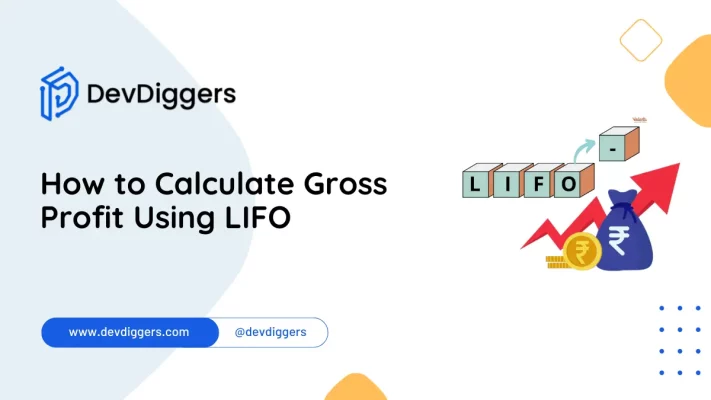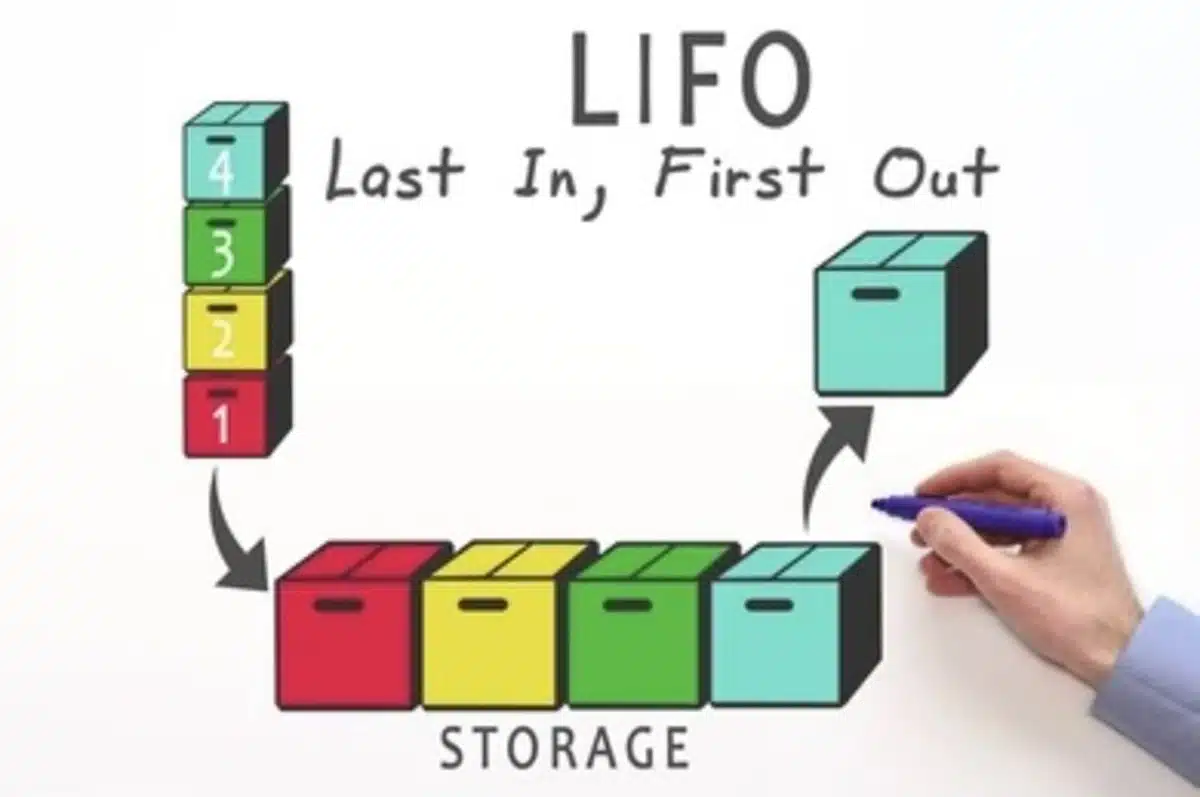How to Calculate Gross Profit Using LIFO

Understanding how to calculate gross profit using LIFO is essential for accurate financial analysis and profitability insights.
The Last-In, First-Out (LIFO) inventory valuation approach claims that the most recently bought inventory is sold first, which affects the cost of goods sold (COGS) and, ultimately, gross profit.
This blog will provide a complete guide on calculating gross profit using LIFO, including its benefits and effects, and step-by-step instructions to analyze your financial performance precisely.
Table of Contents
What is Gross Profit?

Gross profit is a financial term that measures the difference between a company’s revenue and its cost of goods sold (COGS).
It measures a company’s efficiency in producing and selling its products or services.
The Formula for Gross Profit:
Gross Profit = Revenue - Cost of Goods Sold (COGS)
This metric is crucial for determining a company’s profitability and operational efficiency since it indicates how much money is available to cover operating expenses, taxes, interest, and net profit.
What is LIFO?

Before we get started on how to calculate gross profit using LIFO, let’s first define LIFO.
LIFO, or Last-In, First-Out, is an inventory valuation approach in accounting that influences how gross profit is calculated.
This strategy assumes that the most recently acquired inventory items are sold first, affecting the cost of goods sold (COGS) and the ending inventory value.
In periods of inflation, utilizing LIFO can match the most recent inventory costs to current sales, potentially lowering taxable income and enhancing cash flow.
Understanding LIFO is critical for effectively computing gross profit with this method, as it directly impacts financial reporting and profitability analysis.
How to Calculate Gross Profit Using LIFO
Use these instructions to learn how to calculate gross profit using Last-In, First-Out (LIFO):
1. Recognize the Elements
- Sales Revenue: The total amount of money received from selling of goods.
- Cost of Goods Sold (COGS): The price paid for the inventory sold during the given time frame.
- Initial Inventory: The total inventory value at the start of the period.
- Purchases: The price of the inventory that was bought at that time.
- Ending Inventory: The inventory value at the end of the period is known as ending inventory.
2. Determine the COGS Using LIFO
LIFO assumes that the last items purchased are the first to be sold. Here’s how to calculate COGS using LIFO:
Step-by-Step Calculation of COGS:
Step 1: List Purchases Chronologically: Arrange your inventory purchases chronologically, with the most recent purchases at the top.
Step 2: Match Sales with Recent Purchases: To calculate the COGS, match the number of units sold with the costs of the most recent purchases. Continue this process until the total number of units sold is accounted for.
Example Calculation:
Assume you sold 500 items throughout the period and have the following purchase history.
- On January 1, 100 units were bought for $10 each.
- On February 1, 200 units were bought for $12 each.
- On March 1, 300 units were bought for $15 each.
- On April 1, 400 units were bought for $18 each.
To calculate the COGS using LIFO:
The last purchase is April 1: 400 units at $18 = $7,200.
Remaining units needed: 500 – 400 = 100 units.
The next most recent purchase is March 1: 100 units at $15 = $1,500.
Total COGS = $7,200 (from April) + $1,500 (from March) = $8,700.
3. Calculate Gross Profit
To calculate gross profit using LIFO, use the formula:
Gross Profit = Sales Revenue − COGS
Using the example above:
- Assume the total sales revenue for the 500 units sold is $25,000.
- COGS calculated using LIFO is $8,700.
Gross Profit = $25,000−$8,700 = $16,300
How LIFO Affects Gross Profit
In the process of understanding how to calculate gross profit using LIFO. LIFO (Last In, First Out) is an inventory valuation method commonly used in accounting.
Under LIFO, the most recently acquired inventory items are assumed to be the first sold.
This affects the calculation of gross profit in a few ways:
- Cost of Goods Sold (COGS): Since LIFO assumes that the most recently acquired inventory items are the first ones sold, during times of rising prices, the cost of goods sold will reflect the higher prices of the most recently purchased inventory. This leads to a higher COGS than inventory valuation methods like FIFO (First In, First Out) or average cost.
- Ending Inventory Valuation: The ending inventory valuation under LIFO represents the cost of the oldest inventory items still in stock, as the most recent ones have already been assumed to be sold. Rising prices result in a lower valuation of ending inventory compared to FIFO. This lower valuation can lead to lower taxable income since the higher COGS reduces the gross profit.
- Gross Profit Calculation: Gross profit is the revenue minus the cost of goods sold. Since LIFO results in higher COGS due to the assumption of selling the most recently acquired (and usually higher-priced) inventory, the gross profit is lower compared to FIFO or average cost methods.
In summary, LIFO affects gross profit calculation by increasing the cost of goods sold due to the assumption that the most recently acquired inventory is sold first, which results in a smaller gross profit than other inventory valuation methodologies.
Key Points to Consider Before Calculating Gross Profit Using LIFO
Before you start implementing the process of how to calculate gross profit using LIFO method, several vital points need consideration:
- Inventory Valuation: Understand that LIFO assumes the latest inventory items are sold first, which affects how you value your inventory. This method may not accurately reflect the actual cost of goods sold during periods of inflation.
- Impact on Gross Profit: LIFO can result in a lower gross profit than other methods like First-In, First-Out (FIFO), or weighted average cost. This is because LIFO matches the most recent, higher-priced inventory against revenue, leading to a higher cost of goods sold.
- Financial Reporting: Be aware of the implications for financial reporting. While LIFO is acceptable under Generally Accepted Accounting Principles (GAAP) in the United States, it’s not permitted under International Financial Reporting Standards (IFRS) and may affect company comparability.
- Tax Considerations: Understand the potential tax advantages of using LIFO, especially during periods of inflation. LIFO can lower taxable income by matching higher-priced inventory against revenue, reducing taxable profits.
- Consistency: Ensure consistency when applying the LIFO method. Changing from LIFO to another inventory costing method can have significant financial implications and may require disclosure in financial statements.
- Disclosure Requirements: Be aware of disclosure requirements regarding using LIFO in financial statements. This includes information about the method used, its impact on financial results, and any potential risks associated with the technique.
- Industry Norms: Consider industry norms and practices regarding inventory valuation methods. Some industries may prefer LIFO due to its tax advantages or conformity with industry standards.
- Management’s Intent: Understand management’s rationale for choosing the LIFO method and assess whether it aligns with the company’s overall financial strategy and goals.
Conclusion
In summary, mastering how to calculate gross profit using LIFO is essential for financial analysts, accountants, and business owners.
By following the step-by-step guide in this blog, individuals can effectively navigate the intricacies of Last-In, First-Out (LIFO) inventory valuation and ensure precise financial reporting.
Understanding the complexities of LIFO’s impact on inventory valuation, its influence on gross profit margins, and its implications for financial reporting and taxation is crucial.
Like using LIFO, we can also calculate the gross profit using FIFO methodologies.
FAQs
Why is LIFO used for inventory valuation?
LIFO matches the cost of goods sold with the current revenue, providing a more accurate representation of profitability, especially during inflation when inventory costs are rising.
Can LIFO be used for any inventory?
While LIFO can be used for various types of inventory, it’s most effective for products with a short shelf life or those subject to frequent price changes.
Are there any disadvantages to using LIFO?
One disadvantage of LIFO is that it may not accurately reflect the actual cost of inventory on hand, especially during periods of inflation, as it values inventory at older, lower costs.
Is LIFO permitted under Generally Accepted Accounting Principles (GAAP)?
Yes, LIFO is an accepted method under GAAP, but its use in financial statements must be disclosed due to its potential impact on inventory valuation and profitability.
How does LIFO differ from FIFO (First In, First Out)?
Unlike FIFO, which assumes the oldest inventory is sold first, LIFO assumes the newest inventory is sold first. This can lead to different inventory valuations and profit calculations.




